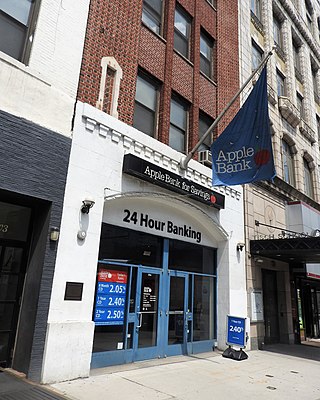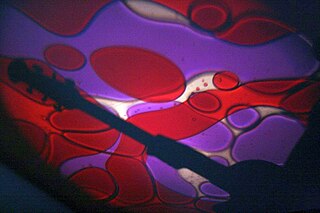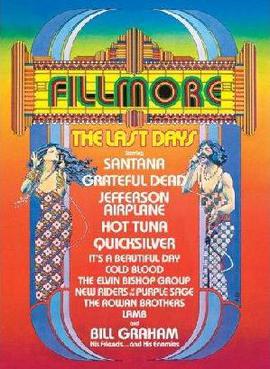
Quicksilver Messenger Service is an American psychedelic rock band formed in 1965 in San Francisco. The band achieved wide popularity in the San Francisco Bay Area and, through their recordings, with psychedelic rock enthusiasts around the globe, and several of their albums ranked in the Top 30 of the Billboard Pop charts. They were part of the new wave of album-oriented bands, achieving renown and popularity despite a lack of success with their singles. Though not as commercially successful as contemporaries Jefferson Airplane and the Grateful Dead, Quicksilver was integral to the beginnings of their genre. With their jazz and classical influences and a strong folk background, the band attempted to create an individual, innovative sound. Music historian Colin Larkin wrote: "Of all the bands that came out of the San Francisco area during the late '60s, Quicksilver typified most of the style, attitude and sound of that era."

The Fillmore is a historic music venue in San Francisco, California.

Bill Graham was a German-American impresario and rock concert promoter.
Chester Leo "Chet" Helms, often called the father of San Francisco's 1967 "Summer of Love," was a music promoter and a counterculture figure in San Francisco during its hippie period in the mid- to-late 1960s.

The Fillmore East was rock promoter Bill Graham's rock venue on Second Avenue near East 6th Street on the Lower East Side section of Manhattan, now called the East Village, in New York City. The venue was open from March 8, 1968, to June 27, 1971, and featured some of the biggest acts in rock music of that time. The Fillmore East was a companion to Graham's Fillmore Auditorium, and its successor, the Fillmore West, in San Francisco.

Winterland Ballroom was an ice skating rink and music venue in San Francisco, California, United States. The arena was located at the corner of Post Street and Steiner Street. It was converted for exclusive use as a music venue in 1971 by concert promoter Bill Graham and became a popular performance location for many rock acts. Graham later formed a merchandising company called Winterland Productions, which sold concert shirts, memorabilia, and official sports team merchandise.
Leigh Stephens is an American guitarist and songwriter best known for being former lead guitarist of the San Francisco psychedelic rock group Blue Cheer.

Fillmore West 1969: The Complete Recordings is a 10-CD live album by the rock band the Grateful Dead. It contains four complete concerts recorded on February 27, February 28, March 1, and March 2, 1969, at the Fillmore West in San Francisco. The album was remixed from the original 16-track concert soundboard tapes. It was released as a box set in November 2005, in a limited edition of 10,000 copies.

The Sons of Champlin are an American rock band, from Marin County, California, in the San Francisco Bay Area, formed in 1965. They are fronted by vocalist-keyboardist-guitarist Bill Champlin, who later joined rock band Chicago, from 1981 to 2009, placing Sons of Champlin on hiatus from 1981 to 1996. They brought to the late ‘60s music scene in the Bay Area a soulful sound built around a horn section, sophisticated arrangements, philosophical themes, Bill Champlin's songwriting and blue-eyed soul singing, and Terry Haggerty's jazz-based guitar. They are one of the enduring 1960s San Francisco bands, along with Jefferson Airplane, the Grateful Dead and Moby Grape.
Robert Wesley Wilson was an American artist and one of the leading designers of psychedelic posters. Best known for designing posters for Bill Graham of The Fillmore in San Francisco, he invented a style that is now synonymous with the peace movement, the psychedelic era and the 1960s. In particular, he was known for inventing and popularizing a "psychedelic" font around 1966 that made the letters look like they were moving or melting.

Download Series Volume 6 is a live album by the rock band the Grateful Dead. It was released as a digital download on October 4, 2005. It was recorded on March 17, 1968, at the Carousel Ballroom in San Francisco. The show features the first set closer "Turn On Your Lovelight" and the whole second set.

So Many Roads (1965–1995) is a five-disc box set by the Grateful Dead. Primarily consisting of concert recordings from different periods of the band's history, it also contains several songs recorded in the studio. All but one of the forty-two tracks were previously unreleased. The album was released on November 7, 1999. It was certified a gold record by the RIAA on April 12, 2000.

The Avalon Ballroom was a music venue in the Polk Gulch neighborhood of San Francisco, California, at 1244 Sutter Street. The space is known as the location of many concerts of the counterculture movement, from around 1966 to 1969. It also had a reopening 34 years later, from 2003 to 2005.

Liquid light shows are a form of light art that surfaced in the early 1960s as accompaniment to electronic music and avant-garde theatre performances. They were later adapted for performances of rock or psychedelic music.

Road Trips Volume 2 Number 2 is a two-CD live album by the American rock band the Grateful Dead. The sixth in their "Road Trips" series of albums, it was the first to contain a complete concert—the February 14, 1968, show at the Carousel Ballroom in San Francisco, California. Bonus material on Disc 1, as well as the bonus disc offered to early purchasers, comes from the Grateful Dead and Quicksilver Messenger Service "Tour of the Great Pacific Northwest", immediately preceding the Carousel Ballroom show. The album was released on March 21, 2009.

Fillmore — also known as Fillmore: The Last Days, and as Last Days of the Fillmore — is a music documentary film, primarily shot at the Fillmore West auditorium in San Francisco, California, from June 29 through July 4, 1971. It was released on June 14, 1972.

Fillmore: The Last Days is a live album, recorded at the Fillmore West in San Francisco, California from June 29 to July 4, 1971. It contains performances by 14 different bands, mostly from the San Francisco Bay Area, including Santana, the Grateful Dead, Hot Tuna, Quicksilver Messenger Service, and the New Riders of the Purple Sage. It was released by Columbia Records in June 1972 as a three-disc LP. It was re-released by Epic Records in 1991 as a two-disc CD.

Live at the Carousel Ballroom 1968 is a live album by Big Brother and the Holding Company featuring Janis Joplin. The album was recorded by Owsley Stanley in 1968, and released on 12 March 2012 through Columbia and Legacy, on the one-year anniversary of his death in an automobile accident. He had been supervising the development and release of this album right up to the time of his death on March 12, 2011. The album is dedicated to him, and set to the specifications Stanley set prior to his death.

California Hall, originally named Das Deutsches Haus, is a historic commercial building and event venue built in 1912, and located in the Polk Gulch/Tenderloin neighborhood in San Francisco, California. It started as a German social meeting hall. At the 1965 Year Years Ball, a fundraiser took place in the building for many gay charities, and brought trouble with the police and a legal battle. The event marked a turning point in gay rights in the west coast. It later was a popular concert hall in the mid-1960s and 1970s; performers that played at the California Hall include Jefferson Airplane, Moby Grape, Big Brother and the Holding Company, the Grateful Dead, and Quicksilver Messenger Service.

















